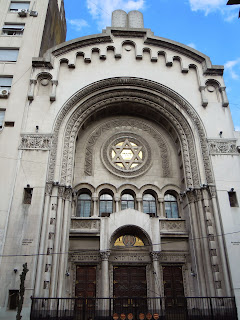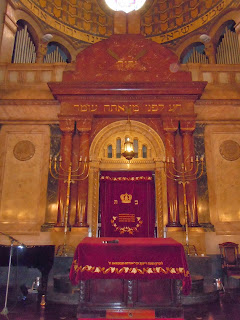This past November, my husband Micah and I travelled to Argentina on a late honeymoon. We spent the majority of our two weeks hiking and boating in the Patagonian region, but our last two days were spent in Buenos Aires. We wasted away lazy afternoons in many of the city parks watching families and their dogs enjoying
their springtime weather while we relished the last days of warmth before heading back to our cold midwestern winter.
 |
The exterior of Templo Libertad. Note the tablets
at the top- similar to those at Ahavas Sholom! |
But before I could tackle all this relaxing, I had to see the gem of the city: Templo Libertad. We had only just dropped our luggage at the hotel minutes ago and I was already waiting impatiently at the door to head down the street. I strategically planned to stay a mere five blocks away from the synagogue. Camera and map in hand we headed out at 4:45 on Thursday afternoon. One guidebook stated the synagogue was open until 5:00. The synagogue's website said 3:00, and another guidebook didn't even include the opening hours. In addition, I had called a few days ago receiving no response. We had become accustomed to this type of confusion over the past two weeks and as a result, had missed out on several restaurants and other attractions. I was determined not to let this happen again. Knowing that the next day, Friday, was the start of Shabbat, I was afraid that if I didn't get in Thursday afternoon there would be no hope of seeing the building's interior. We ran down the sidewalk, dodging Yorkies, a few homeless squatters, cafe tables, baby carriages and flailing cigarettes and arrived at the synagogue on Libertad street which appeared to be completely secured, locked up, and just downright closed. I rattled the gate, walked to a side door and rang the bell. A few seconds later, a man arrived and told me the synagogue as well as the museum were closed. A feeling of sadness rushed over me but then I realized I had a human being in front of me! Not a guidebook! or a website! not voicemail! "What are tomorrow's hours?!" I managed to squeeze out between breaths. The guard said "11-3" just before closing the six-inch thick wood door in my face. I considered this success.
 |
| Yours truly in front of the synagogue. |
Needless to say, we returned the next day at 11am. At the entrance, like any museum, they requested we purchase a ticket. However, unlike other museums in Argentina, they did not want pesos... they wanted US dollars. We paid for two tickets with a $20 bill and were directed to a young man who unfortunately had the flu, to give us a introduction to the museum. We walked through the 5-6 galleries which were elegantly done. The artifacts, like Argentina's Jewish population, came from all over the world. Captions and other museum text were in English as well as Spanish. A technique I really appreciated was their use of drawers. Each display case had 3-6 flat drawers underneath which visitors could, according to their own desire, pull out to read a letter, see a textile, or examine a silver platter. What a wonderful way to display 2D and low-profile items. I've seen this done before in children's museums and I've also seen this done in visible storage applications, but I thought this melded nicely within a formal history/art exhibit as well. In addition to the 2 and 3D artifacts, we viewed a short film on the Jewish Gauchos who settled in Moises Ville at the turn of the century. To read more about this fascinating commune funded by Baron de Hirsch, please check out this
article.
 |
Templo Libertad's sanctuary. Each pew had
a brass name plate. |
 |
The bima of Templo Libertad. Note the organ
pipes pictured at top. |
 |
| A stained-glass chandelier in the foyer. |
After finishing our tour of the museum, we moved on to a guided tour of the sanctuary itself. While this grandiose Byzantine-revival synagogue was completed in 1932, the congregation was formed over 70 years prior. The sanctuary was gilded in gold, festooned with marble imported from Europe, and embellished with incredible stained glass windows. The synagogue's congregation is Conservative today and according to our guide, the balcony was never used for women's seating but rather overflow seating. Also according to our guide, the organ pipes pictured above are working pipes. I would disagree because often religious buildings showcase faux pipes. The pipes doing all the work aren't all that pretty and uniform and need to be easily accessible for maintenance and repair. Regardless, we can glean a lot of information from this building, the people who built it, and the Jewish community today. First, the
bima is at the front of the sanctuary which tells us that the service is more of a production than a participatory event where the
bima is in the center of the sanctuary. Second, the organ is typical in the Reform movement but the balcony is typical of an Orthodox synagogue, yet the congregation is Conservative! Finally, we see a piano and a microphone at the front of the sanctuary. While I'm not positive these are used on Shabbat, these are hints that this congregation uses music as part of their services. If I was a specialist in architectural history or the history of the Jews in South America, I'm sure I would be able to extract even more information from this incredible building.

After our 2-hour tour of the museum and synagogue, we were hungry and decided to trek over to the only Kosher McDonald's outside of Israel. When we got there, in classic Argentine style, it was closed... unannounced.





 After our 2-hour tour of the museum and synagogue, we were hungry and decided to trek over to the only Kosher McDonald's outside of Israel. When we got there, in classic Argentine style, it was closed... unannounced.
After our 2-hour tour of the museum and synagogue, we were hungry and decided to trek over to the only Kosher McDonald's outside of Israel. When we got there, in classic Argentine style, it was closed... unannounced.